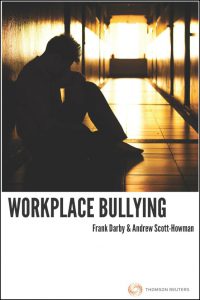Bullying in the workforce
 Andrew Scott-Howman discusses the need for a knowledgeable, independent investigator
Andrew Scott-Howman discusses the need for a knowledgeable, independent investigator
On 4th April 2016 the new Health and Safety at Work Act (2015) came into force, giving broad responsibilities to employers, including having to take reasonable steps to safeguard their employees from harm which may arise as a result from bullying in the workforce. Since specific guidelines to manage bullying were introduced in 2014 the number of cases in New Zealand workplaces has increased. Andrew Scott-Howman, barrister and employment law specialist, says that this indicates both a greater awareness of the issue (and therefore an increase in reporting) as well as a persistent problem with New Zealand's work culture.
He also warns that there are significant traps for employers who try to handle workplace issues without expert advice. Often, he says, a path that appears reasonable may in fact cause major problems further down the track. Succumbing to the temptation to short cut processes, inexperience or naivety, he says, ultimately makes a difficult situation far worse.
The value of training
 Andrew has recently completed an intensive specialist course with the Association of Workplace Investigators in the USA on workplace investigation. The training, he says, not only ensured that he has the best of techniques at his disposal but it also reinforced the value of independent investigation.
Andrew has recently completed an intensive specialist course with the Association of Workplace Investigators in the USA on workplace investigation. The training, he says, not only ensured that he has the best of techniques at his disposal but it also reinforced the value of independent investigation.
When the decision is made to formalise a process to investigate a workplace complaint an investigator must comply with “natural justice” principles. Strict adherence to procedural fairness must be applied to both sides of a case and actions undertaken in the investigation must be free from bias.
A finding made through an investigation process which is ultimately found to have been flawed can be set aside - rendering the entire process, and its conclusions, worthless.
Using an independent investigator (who is aware of these particular requirements and how they must be applied in practice) can be the best way to ensure compliance with the relevant legal obligations.
The salutary tale of the airline pilot and the flight attendant
In H v A Ltd [2014] NZ Emp C 189, 7 October 2014, Mr H (57 yrs) was employed by A Ltd as a pilot. A flight attendant (19 yrs) complained that Mr H had sexually harassed her during a layover. The employer, A Ltd, subsequently dismissed Mr H on the ground of serious misconduct. The Employment Relations Authority had held that the decision to dismiss was justified, but Mr H successfully appealed that decision to the Employment Court.
The Court found that when there is a serious reason for dismissal, such as sexual harassment, then the evidence supporting it must be convincing. In this instance, A Ltd had failed to adequately investigate or consider Mr H's explanation. For example, Mr H had been questioned in a "penetrating and, at times, a relentless fashion", whereas the complainant had not been submitted to a similar level of scrutiny.
Mr H was reinstated to his former position by the Court, which also recommended that Mr H be directed to undertake counseling or therapy and be the subject of a written warning. A Ltd was also ordered to pay Mr H $7,500 in compensation, as well as compensation for lost superannuation benefits, and 50 percent of his lost wages. These amounts were reduced because of Mr H's contributory conduct.
Did Mr H sexually harass the flight attendant? Was the initial investigation biased in favour of the flight attendant through natural sympathy or empathy for the underdog - in this instance a comparatively lowly ranked and young, girl?
The opportunity to answer the first question unequivocally was lost – compromised by the way the investigation was conducted. He may, or may not have. The case morphed into a debate over procedural fairness, leaving its originating concern unanswered.
The answer to the second question is that bias was apparent and, while its presence might be understandable, it cost the defendant dearly.
According to Andrew, even lawyers and HR professionals who are otherwise familiar with workplace issues must proceed with care, and real knowledge of the relevant rules of law. The investigation process is full of pitfalls, and is (as this case illustrates) easy to get wrong - with disastrous results for all parties.
Some general requirements for investigators and investigations
- The investigator must be free from bias. Any previous relationship with one of the parties to the dispute may cause an allegation of apparent bias to be made.
- The investigator must hear from both sides to a disputed fact on a fully informed basis – which means there must be full and complete disclosure of all information collected by the investigator.
- Meetings should ideally be in person, but are not required to be so. Information may be gathered by video link, telephone or in writing if doing so is reasonable in the circumstances
- The investigation should be concluded in a timely manner. No good purpose is served by delay.
A slip up in any one of these aspects could result in the investigation, and its findings, being challenged.
Changing work habits when investigating workplace bullying issues
Andrew says changing deeply ingrained personal work habits is difficult. Lawyers are, by their nature, used to being advocates for one side of a workplace dispute. However he warns that if lawyers want to succeed as investigators they must be prepared to leave old ways of doing things behind. An investigator is required to sit in unbiased judgment on the facts as they are presented, and should not be drawn into any empathetic support for one side or another.
What follows are some of the tips shared by the Association of Workplace Investigators, and which Andrew now employs.
Privilege does not apply
When an employer instructs an investigator a solicitor/client relationship is not created. By the nature of the role, the investigator must be truly independent of the employer. What this means is that any communications from the employer are not privileged and may have to be disclosed to the parties as part of the obligations of natural justice.
Make recordings
Andrew advises making recordings of every interview had as part of the investigation, rather than making notes or otherwise creating written records for interviewees to sign. Thanks to technology, sound recordings can be made easily, and shared with the parties to the dispute immediately. They do not require confirmation by an interviewee (ie that this is the person's evidence), and they are the best evidence of what was said. He prefers not to create transcripts - simply because of the additional delay and cost in doing so. This is a shift from the traditional reliance on written material which may be a paradigm shift for some lawyers and HR professionals.
Be sure to prefix your recordings with the appropriate admonitions and/or disclaimers
These explain in clear unequivocal language what is being recorded, who the recording will be shared with, and why. This satisfies Privacy Act requirements and gives each interviewee information about what will happen to the information they are about to provide.
Nothing is “off the record”
Do not receive information on the basis that it will not be shared with others – ie by talking to an interviewee “off the record”. Doing so breaches natural justice requirements by failing to ensure that both sides are heard on a fully informed basis, and it also runs the risk of giving rise to an allegation of apparent bias.
Keep it simple
Aim to do around 10% of the talking. Plan your questions carefully. Keep them, and the language you use, simple.
The rules of evidence do not apply
A judicial forum is limited in the information that it can receive because of the rules of evidence. Hearsay and propensity evidence is inadmissible in a formal tribunal. This is not so for an investigator. While it may be less reliable, hearsay or propensity information may guide the investigator down lines of enquiry which assist in reaching a finding on the issues before him/her.
As well as sticking to the procedural guidelines, a decision must be reached
The task of the investigator is to make a decision to the balance of probabilities. The decision should be reasonably made on what has been presented through a full and fair process. This is not the same as establishing the "truth", simply what is a reasonable conclusion after a proper investigation.
More information on workplace bullying
![]() WORKSAFE NEW ZEALAND is the official government site offering information and resources on all workplace health and safety issues - of which bullying is one.
WORKSAFE NEW ZEALAND is the official government site offering information and resources on all workplace health and safety issues - of which bullying is one.
Bullying is a significant workplace hazard that affects employee health and business productivity. Employers have a duty to control all workplace hazards, including bullying and other undesirable behaviour.
To find out more please click - Bullying - Preventing and responding to workplace bullying
What is workplace bullying? A definition
Workplace bullying is repeated and unreasonable behaviour directed towards a worker or a group of workers that creates a risk to health and safety.
It can come from other workers as well as patients, clients, students, customers and members of the public.
Repeated behaviour is persistent and can involve a range of actions over time.
Unreasonable behaviour means actions that a reasonable person in the same circumstances would see as unreasonable. It includes victimising, humiliating, intimidating or threatening a person.
A single incident of unreasonable behaviour is not considered workplace bullying, but it could escalate and should not be ignored
Task related bullying
Task related attacks (indirect) can include:
- Giving unachievable tasks - impossible deadlines, unmanageable workloads - 'setting a person up to fail'
- Making hints or threats about job security
- Meaningless tasks, unpleasant jobs, which belittle and undermine a person's ability
- Withholding or concealing information, failing to return calls or pass on messages
- Undervaluing contribution, no credit where it's due, a person taking credit for work that's not their own
- Unreasonable or inappropriate monitoring - offensive sanctions: eg. denying leave
Direct and personal bullying behaviours
Personal attacks (direct) can include:
- Belittling remarks, undermining integrity, lies being told, sense of judgement questioned, opinions marginalised
- Ignoring, excluding, silent treatment, isolating
- Suggestive glances, gestures, or dirty looks
- Ridiculing, insulting, teasing, 'funny surprises', sarcasm
- Intimidation, acting in a condescending manner
Where to get help
Talk to Andrew Scott-Howman – Barrister – Port Nicholson Chambers, Wellington
– Barrister – Port Nicholson Chambers, Wellington
Andrew specializes in employment law. He is frequently interviewed on employment issues by Radio NZ, and is the co-author of the forth-coming text Workplace Bullying - an educational and practical resource referencing WORKSAFE NEW ZEALAND's Guidelines for employers, managers, and workers.
- NZ Herald article - 10 tips for dealing with workplace bullying - an excellent initial reference
- WORKSAFE NEW ZEALAND – Bullying – Preventing and responding to workplace bullying
About the book
 This is a new groundbreaking book - an invaluable reference for lawyers specializing in employment, health and safety law, Health and Safety Consultants, human resource professionals, managers, employers, CEOs, company directors, unions and employees. Find out more.
This is a new groundbreaking book - an invaluable reference for lawyers specializing in employment, health and safety law, Health and Safety Consultants, human resource professionals, managers, employers, CEOs, company directors, unions and employees. Find out more.